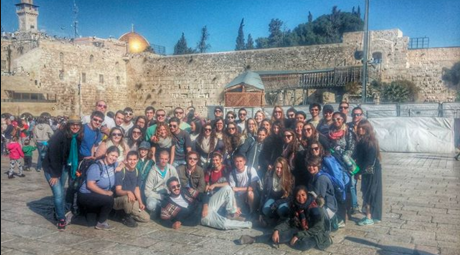
A Magical Day In The Old City
We step off the bus: the sun beats down, hot on our heads and backs even as a cool breeze blows as we stand in front of the wall that separates the Old City from West Jerusalem. The sky is a pure, deep blue, not a cloud in sight, and the sand-colored stones of the wall shine faintly in the sunlight. The ancient stones are slippery under our feet as we walk forward, around the wall, but not into the city yet; church bells toll, and men with dried fruit carts shout, offering their fruit for twenty sheckles per container.
Then, we walk through the wall. The city expands around us, smooth, sand-colored stone all around—voices stream around us, in English and Hebrew, as we enter the Old City, one of the holiest places In Israel, a place that people dream of seeing for themselves.
The Old City—our first stop of the day after a two-and-a-half hour bus ride to the south, passing famous places like Jericho, and the border to Jordan—was beautiful; I could practically feel the history radiating out of the stones as Ido led us through the streets, some of which were thousands of years old (and some somewhat-recently refurbished).
Every few minutes, Ido would stop the group, pull out a paper fold-out that was at least a foot taller than him and covered with pictures outlining the different periods of Israeli history, and tell us about the histiory of the place where we had stopped. At the first, Roman columns lined the middle of large, open rectangular space, their tops intricately decorated, though incomplete, since the object—a doorframe or a roof—was long gone; then we walked through a doorway in the wall, into a room whose main focus was a mosaic, from ancient times, showing a picture of the Old City. The Mosaic was found in the ruins of a Christian civilization—of course, the one in the room was just a replica, but still.
Next, we walked through another doorway into a corridor that existed in Roman times, was buried and the rest of the city built on ground above it, and forgotten, until archeologists, who had read about all these Biblical places and wanted to see them for themselves, dug the corridor up again. The floor was made of the same stone as the rest of the City, but cut in large squares, and set unevenly, and a curved roof covered the corridor; it wasn’t there originally, but city officials decided that the roof was a good idea, so it was built. More columns line the right side of the room, unatttached to anything like first ones; the front wall is painted with a mural of what the corridor would’ve been like during Roman times. Colorful men and women, in robes and togas, line the streets, which are bustling and lines with stores. But in the mural are also: a little boy in a T-shirt and basketball shorts, talking to a man at a vegetable cart—and the Mayor at the time the mural was painted, who asked the artist to put him in. Bridging the ancient and modern city.
Then, we continued on, into the residential part of the city, which was full of shops, and a lot more, less tourist-y people. We didn’t stop anywhere to eat or shop; instead, we walked out to a big balcony, which overlooked the city, and the Western Wall. We stopped there for a moment while Ido talked to us, and then we went down the stairs, through the metal detectors and bag scanners, and finally, out to the plaza, on the far side of which was the Western Wall, or Kotel.
We had about half and hour of free time, to go to the wall for those who wanted to. I went; there were two different sections, one for men and one for women, separated by a waist-height fence, which surprised me, and another section, farter down the wall, that was establishd recently, and which allows both geders to pray together, which, Ido said, was a huge step, culturally. That section was kind of hard to find, though, so I just went to the womens’ section. It wasn’t super crowded, but it wasn’t empt, either; the wall was lined with women (and the same for the mens’ side, too, from what I could see over the fence), some praying and holding books in their hands, with their foreheads pressed to the stone, while others just walked to the wall, stuck their paper in one of the cracks where there was room, then backed away, careful not to turn their backs on the wall.
My friends wrote notes and put them into a wall; I did, too, though mine was short, since I didn’t really know what to say. Then, the half hour was up and the group came back together. That was it for the Old City—we walked right back out and onto the bus, set for lunch in West Jerusalem. After that, we drove to the new kibbutz and our new rooms, ready to start services for Shabbat to say goodbye to this old—and so far, reall busyy—week, and finally get a little break.
Shabbat shalom!

